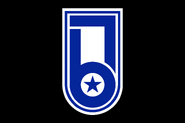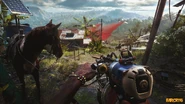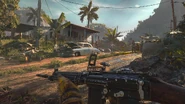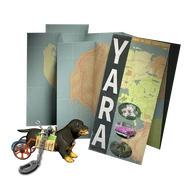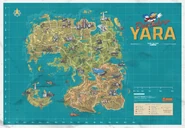Ever since the election of Antón Castillo to office in 2019, the country has been molded into a totalitarian, fascist and hereditary dictatorship which lacks the slightest of subtlety, employing slave labor and committing mass murder in plain sight of the public. The Yaran military under Castillo’s regime is the Fuerzas Nacionales de Defensa. The national anthem of Yara is Himno Nacional Yarano.
Past of Yara[]
The Taino were the natives of the Caribbean including Yara, and faced few horrors except occasional Carrib invasions who originated from the Amazons. Their history took a dark turn when Columbus discovered the Caribbeans and rampaged around the region, ravaged and massacred the natives including the native Taino in Yara. This sparked native revolts against Spanish rule, that raged on even after the death of Columbus in 1506 until the last Taino native chief of Yara was executed in year 1512.
Unlike native Taino elsewhere across the Caribbeans who survived, Spanish invaders committed genocide against the native Taino in Yara, whose survivors probably left the islands to live with other Taino elsewhere as Spanish invaders intensified slavery, hence the absolute absence of native Taino presence in Yara today.
Without native Taino to enslave for plantation labor, Spanish invaders filled the islands with African slaves to profit from colonial plantations that grew tobacco and sugarcane, as well as smaller sources such as textile ran by the slave owner Gofredo Bezos, whose descendants also went down the same path. With tobacco and sugarcane from slave labor, Spanish invaders further profited through cigar, sugar and rum industry, which were also operated by slavery.
In 1702 Spain sent General Diego Caballero to build Escila Fort in response to rampant piracy across the Caribbeans, especially the pirates led by Ignacio Corso. Through Escila Fort, Spanish military defended Yara from Portuguese invasions and threats from the Dutch, although the latter was possibly Dutch pirates and not outright invasion by Dutch military, as Spain and Netherlands saw no significant clashes after 1648.
Spanish colonial atrocities ultimately resulted in slave revolt led by Iselda the Machete, although that's not her real name. She defeated Spanish military in Yara, thus the slave population gained freedom and independence.
Strangely enough, despite Spain themselves started opposing slave trade from 1815 onward and spent entire 19th century abolishing slavery in everywhere possible, the monument in El Toro Square claim that from 1893 to 1916 Spain still sent General Diego Caballero to crush slave revolts, possibly because the latter shares his name with the other Diego Cabarello who defended Yara from piracy. While this second General Diego Caballero couldn't bring back slavery, his brutal oppression of Yaran former slaves resulted in total economic and political collapse.
At some point prior to March 15, 1916, the Spanish government appointed Geraldo Montano to serve as Governor of Yara. A plaque in Segunda states that Governor Montano assisted in a revolution on this date, resulting in Yaran independence.
Despite Yara declared independence from Spain in 1916, Antón Castillo Independence Day speech in 2021 mentioned that they were celebrating 100 years of independence, implying that Yara became fully independent in 1921.
By modern time, Yara was previously considered a prosperous and peaceful nation, at least on paper. Gabriel Castillo, the former president of Yara and father of Antón Castillo, led the nation in the style of the CIA-supported fascist Central and South American governments of those years such as Cuba, Guatemala and Paraguay. This wouldn't last long as in 1967 , bolstered by the flames of the Cuban Revolution and countless other communist revolutions across the world, communist guerrillas in Yara led by Santos Espinosa also started the Revolution of 1967 which overthrew the Castillo family and the father of Antón was executed right before his eyes.
Due to the untimely communist revolution right after Cuban Missile Crisis and in the middle of Vietnam War, Yara fell out of favor with numerous western countries, namely the US, which resulted in economic sanctions that crippled the country's economy. However, Yara had a lifeline in the form of the Soviet Union and other such communist states (nominally the near Republic of Cuba) who provided economic and military support. Yara seemed to be stabilizing, until the early 1990's when the Soviet Union fell and Yara went into a freefall. In the 20 years that followed, and despite the economical help from states such as Cuba and Venezuela, Yara continued to experience major economic decline, political and social instability and growing national debt.
Eventually in 2019 Antón himself was elected El Presidente, on the promise of rebuilding Yara.[1] However, if there's one thing that history teaches us is that those who don't remember it are destined to repeat it. In Antón's case, he had no problem doing that since in the following seven years, Antón's regime cracked down on political dissent, fundamental freedoms and democracy in the country, with anyone who dared to speak out against his methods or regime being sent into slave labor camps or outright executed without trial.
Economy[]
Under Spanish colonialism, Yara did not have a functional economy, as they only relied on sheer slave labor in colonial plantations that grew tobacco and sugarcane, as well as turning such products into cigar, sugar, and rum, also operated by slavery.
After the end of slavery and Yara independence in 1916, the island economy was diversified and became somewhat more self sustainable, although they were still heavily dependent on export of tobacco, sugar and rum, just like Kyrat whose post-colonial economy was dangerously dependent on gold mining, which ultimately resulted in economic collapse that escalated into a civil war.
By 21st century however, Yara has suffered under international economic sanctions for decades, leaving it stuck in the past technologically, and its people impoverished and divided. Under the leadership of Antón Castillo this has only been exacerbated leading to him tightening control of country under his iron grip.[2] In addition, Yaran Pesos are considered worthless on the global exchange market by 2021.[3]
Just like Pagan Min regime desperately expanding gold mining to save the Kyrat economy during their second civil war, Antón Castillo regime is also desperately expanding the Yara tobacco industry for the production and export of Viviro.
As the Antón Castillo regime grew greedy and eventually became desperate to keep up Viviro production, they found the answer in Yara's brutal history: the islands tobacco industry ran at their best production capability by slave labor under Spanish colonialism. Unfortunately, they learned the wrong lesson from history, thus, slave labor was brought back in 21st century Yara.
Politics[]
Until 1967 Yara had been a facade of a democratic state with a presidential republic system, in reality the power belonged to Castillo's military junta. After the communist revolution, Santos Espinosa stayed as president for life so Yara had no real elections, and the military was supposedly uninvolved in politics, as everyone distanced themselves from the corrupt and incompetent Santos Espinosa. After the fall of the Soviet Union in 1991 and Yara's subsequent descent, the communist regime fell out of favor with the people and was eventually replaced by the old democratic system.
With the old system of democracy restored, Antón Castillo was able to manipulate the system and get elected as El Presidente, reverting the nation back to the tyrannical reign of Castillo's military junta again, albeit under a different ideology and a far more violent dictatorship at that.
Antón Castillo began to structure his new state along the principles of fascism (reactionary ultranationalism) with full power vested in him under the state’s military junta as their El Presidente.
Antón Castillo also began to groom his son, Diego Castillo, when he was 13 years old to succeed him as the President of Yara, demonstrating his ambitions to start a line of hereditary leadership in the state and ensure that the Castillo family would become a ruling dynasty, with Diego in the third generation and possibly more to come.
At first, Antón's policy of enslaving dissidents and political prisoners for Viviro production was still supported by the public, since prison forced labor on tobacco fields was already a common punishment in Yara for centuries, with Antón himself was punished this way by the communist leader Santos Espinosa.
However, when he expanded slavery to include poor people in general, Yara became unstable and rampant violence erupted, as the overwhelming majority of Yarans have military training due to being former conscripts and FND veterans.
Yaran Cabinet[]
Yara's cabinet is composed of numerous Ministries, which work under Antón Castillo. The most important and well-known of these is the Ministry of Culture, led by María Marquessa. However, other Ministries are mentioned, most notably on billboards.
Here are the known Ministries:
- Ministry of Culture (Lead by María Marquessa), known members include Daniel Estrada.
- Ministry of the Navy (Lead by Admiral Aña Benítez), known member include Raúl Marín.
- Ministry of Food, Import, Export, and Distribution of Firearms (Lead by its Minister)
- Ministry of Agriculture
- Ministry of Sport
- Ministry of Defense
- Ministry of Health, possible member include Édgar Reyes and Emilia Rocha.
- Ministry of Construction
- Ministry of Reconstruction
- Ministry of Education
- Ministry of Public Works
- Ministry of Public Services
- Ministry of Internal Affairs
- Ministry of Energy, possible member include Juaneta Cuda.
- Ministry of State
- Ministry of Tourism, possible member include Rosamaría Cuda.
There also exists a nature preserve in Barrial, under the name of 'Ministry of Panthers.' According to a letter left by Maria Marquessa, it is not recognized by any Yaran government agency, and never will be.
It remains unclear exactly what happened to Yaran police. During La Noche de la Muerte, Dani pointed out how Yaran police are unusually absent and Yaran military can do whatever they want without any regard to the law. Apparently, Yara used to have police throughout Dani's life up to that point, as La Voz de Yara wrote "Two police cars appear but, in the blink of an eye, the domino players are gone." While the reason behind such absence remains unknown, the role and fuction of Yaran police are filled by Yaran military, as seen when rioters were confronted by FND Riot Soldiers instead of Yaran riot police.
Modern-day[]
Antón and his son, Diego, have begun a bloody and oppressive campaign in an attempt to restore Yara to its former glory. Antón has enforced sanctions in Yara and limited trade with foreign nations, deployed the Yaran military throughout the nation to carry out his plans and keep citizens in check, and restricted mobility within the country through controlled checkpoints.
In addition to this, in order to make the country more appealing to foreign investment and to bypass international sanctions, the Castillo regime has begun research into an anti-cancer drug known as Viviro, produced from Yara's tobacco plantations. To help distribute Viviro globally, the Castillo regime has sought the assistance of Canadian business magnate Sean McKay to manage Viviro exports overseas.
However, the production of Viviro relies on slave labor in the form of Yara's poor forced to work in tobacco plantations, and it is implied that Viviro's success rate in mitigating cancer is dubious at best. The excessive abuses and brutality of Castillo regime sparks a revolution in Yara again, led by various groups of guerrillas who oppose Antón, especially the Libertad.
Future[]
- If Dani Rojas joins Libertad, Castillo regime would rapidly collapse within the later half of 2021. Unfortunately, Libertad leader Clara García dies before the work is done. Without her leadership, Libertad and other guerillas cannot hold the country together, Yara became unstable as remnants of Yaran military refuse to surrender, continuing to abuse civilians and fighting against Libertad across the country. The remnants of Yaran military often form insurgencies and seizing back control of certain unstable areas. In this case, Yara becomes an unstable failed state just as Antón Castillo has predicted, as the Liberad would most likely repeat the mistakes of the 1967 revolution, which plunged Yara into economic decline as they did not seem to know how to manage the country after their successful revolution, worse, unable to stabilize the country as insurgencies continue wrecking havoc. However the leaders of Libertad, the Montero Family faction, Maximas Matanzas, La Moral and the Legends of 67, despite the situation, take to heart what Dani told them before the successor of Clara Garcia took the dead body of Diego and went to bury him. "The only reason we are standing here is because we didn't wait for one person to solve all our problems. When tyranny is law, revolution is order. Yara is yours, don't fuck it up." For the time being, a council of these groups is made as the provisional government of Yara. Despite some setbacks and the insurrections caused by Castillo's supporters, things might be starting to get better but only time will tell. But one is for certain. As long as Dani Rojas continues to fight these insurgencies, Yara may finally have that bright future that the people has been waiting for since 1967.
- If Dani Rojas takes the boat to leave Yara and live in the US, it's unknown what would happen to Yara, all that can be heard is: three months after Dani's departure, Yara is still under Castillo's regime. The Yaran military, or at least their special forces, are still active. Antón managed to live on for 3 more months, claiming that his special forces killed Clara Garcia and that "war has ended in Yara." Whether that is true or not is left unverified due to Castillo's regime's tight censorship. If the war is indeed not over yet, then Libertad and other factions must still be around. The fate of numerous people in Libertad is left unknown.
Locations[]
Yara is divided into 5 main regions which are further divided into smaller districts, referred to in-game as Provinces. Within Provinces, road signs and painted rocks mark the borders of the even smaller Municipalities. These regions are each controlled by important figures of the FND.
- Isla Santuario
- Zamok Archipiélago
- Libertad Island
- Madrugada
- Costa del Mar
- Lozanía
- Aguas Lindas
- El Este
- Sierra Perdida
- Conuco
- La Joya
- Valle De Oro
- Balaceras
- Cruz del Salvador
- Noventarmas
- Barrial
- Esperanza
- Isla del León
Trivia[]
- Similar to numerous Caribbean islands, Yara had native Taino tribes before the arrival of Spanish invaders, and most of the names today are from Taino language, such as Bahamas, Cayman, Jamaica, Haiti, Havana, etc... as in Yara case, "Yara" means "place" in Taino language.
- Yara does NOT replace Cuba which has already existed in the game universe with a Cuban character, implying that the two countries are simply in the same Caribbean region.
- Since Yara and Cuba are neighbors, it's unknown what is Cuba's response on Yara's production of Yaran SR-A, a nearly identical copy of the Alejandro sniper rifle from Cuban military.
- Inspiration for Yara was taken from Cuba.[4]
- The capital city of Esperanza shares many aesthetic similarities to Havana, the capital of Cuba.
- Yara has a statue honoring the martyrdom of a Taino chief killed by Spanish invaders, just like Yara, the town of Cuba in the real world.
- The map of Yara strongly resembles the northwest portion of Cuba, with both Havana and Esperanza facing the coast at the northeast, as well as both Isla de la Juventud and Isla Santuario at the southwest.
- Tobacco is an important export of Yara, much like Cuba in the real world. Cuban cigars are prized throughout the world for their quality.
- The business relationship between Canadian national Sean McKay and the Castillo regime echoes how Canada in the real world has open economic relations with Cuba, in contrast to the United States-backed embargo of the island.
- Vintage American cars can be found all over Yara, similar to how Cuba relies on 1950s-era American cars for transport.
- In contrast to Cuba, which is officially a left-wing regime in the modern day, Yara appears to be a right-wing dictatorship similar to the historical regimes of Rafael Trujillo in the Dominican Republic and Augusto Pinochet in Chile. In reality, Cuba prior to the 1960s was run by a right-wing dictator, Fulgencio Batista. However, Yara has propaganda similar to communism and has very little ties to the United States.
- The regime was more similar to that of North Korea from having Diego be the successor to the presidency and Burma under the leadership of Min Aung Hliang that can order soldiers to shoot people who oppose.
- There is a city in Cuba called Yara.
- National Anthem is Himno Nacional Yarano made by Ubisoft music.
- Due to Yara’s relatively small size, it is categorised as a microstate/ministate. Although this is likely due to the scale of the game, as it is most likely intended to represent a much larger place.
- Their politics and election are similar to Myanmar coup in 2021 as both dictators (Min Aung Hlaing and Antón Castillo) reclaimed their country with their military government in an authoritarian way after overthrowing civilian government and other political parties. The difference is that Antón reclaimed his power back my manipulating the free election system and Min Aung Hlaing claimed his power though coup and overthrew Aung San Suu Kyi, the leader of the democratic party National League for Democracy.
- Both countries are struggling to tackle the rebel and insurgencies - both Libertad and other ethnic group rebellion along with PDF (People's Defense Force).
- Despite Yara declared independence from Spain in 1916, Antón Castillo Independence Day speech in 2021 mentioned that they were celebrating 100 years of independence, implying that Yara became fully independent in 1921.
Gallery[]
References[]
- ↑ Far Cry 6 Introduction: "Yara is an island in the heart of the Caribbean
In 1967, a guerrilla revolution led to a crippling blockade
Frozen in time for 47 years, the island collapsed into poverty
Until a new leader was elected with a cure to "Rebuild Paradise"
El Presidente of Yara, Antón Castillo" - ↑ Everything We Know About Far Cry 6
- ↑ Mr. McKay: "Uh FYI, Yaran Pesos are so worthless on the global exchanges right now. I'm basically buying my freedom for the cost of a double-double."
- ↑ Far Cry 6 Dev Explains The New Politically-Charged Setting












